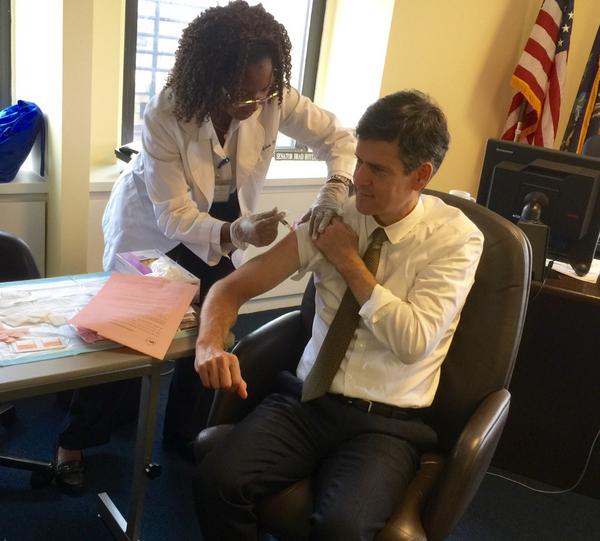
State Sen. Hoylman gets a flu shot (photo: @bradhoylman)
Teenagers aren't the only ones keeping up with the latest technology. Today, nearly three-quarters of Americans over the age of fifty are "plugged in" and regularly using the internet. As we get more connected, however, we're demanding the same of our medical care. Because many patients often have multiple doctors, it's important that all of their providers have access to their medical records.
This year, Governor Cuomo's budget again includes support for the continued development of New York's Statewide Health Information Network (SHIN-NY). This important state investment will enable patients and their doctors to seamlessly exchange electronic health records wherever they are in the state. The network is already gaining momentum: over 50,000 doctors and healthcare providers participate in SHIN-NY, and over 7 million New Yorkers have given consent to have their records shared.
SHIN-NY will be a game-changer for millions of people in New York State, especially those living with chronic conditions. Sixty percent of the American population over the age of fifty may have at least one chronic illness, whether it's heart disease, cancer, diabetes, or arthritis. In fact, many have more than one condition. For these New Yorkers, SHIN-NY will greatly simplify and improve the way medical care is delivered.
For example, it will no longer be necessary to hand-carry blood tests, x-rays, MRI scans or charts between doctors. If you're away from home and have an unexpected emergency, it means the doctor treating you will be able to access your health history, including drug allergies and pre-existing conditions, in order to provide the best possible care.
SHIN-NY will also help doctors share vital care information with other doctors, greatly improving the coordination of your care. This is critical, for example, if you see multiple doctors or have several medical conditions because doctors can make sure that the medication they prescribe doesn't conflict with your other medications or conditions.
Further, SHIN-NY will allow doctors and providers across healthcare settings to work together to address different parts of a person's illness. For example, a woman who recently had open-heart surgery and is a diabetic can be assured that her cardiologist, dietician, and primary care physician are coordinating effectively by accessing information through SHIN-NY to ensure she fully recovers from the surgery and receives proper, post-operative care, even after she's been discharged from the hospital.
Longer-term, increased care coordination will dramatically impact the cost and quality of healthcare in New York by reducing hospital re-admissions and avoiding unnecessary tests. And, this coordination will have the most profound impact on New Yorkers over the age of 50.
With budget negotiations ongoing, I urge the New York State Senate and Assembly to join Governor Cuomo in renewing their efforts to continue the development of the SHIN-NY.
***
by Carol Raphael, a board member of the New York eHealth Collaborative and former CEO, Visiting Nurse Service of New York.
***
Have an op-ed idea or submission for Gotham Gazette? E-mail editor Ben Max: This email address is being protected from spambots. You need JavaScript enabled to view it.




